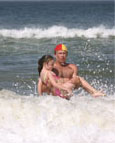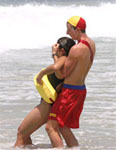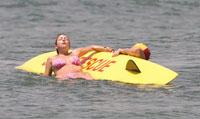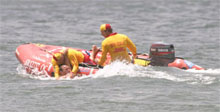Rescue Methods/Statistics
Introduction
This section details the techniques that have been developed over the years for rescuing people from the surf. The rescue of people is the second most important set of skills taught to lifesavers – prevention being the first. To evaluate the risk and the method to use in a rescue, the lifesaver needs to assess:
- the surf conditions
- the patient’s condition
- the equipment available
- the best rescue method to use
A rescuer may encounter a variety of situations while assisting a person in trouble. All rescues involving white water should be regarded as being particularly critical for the patient. By displaying initiative and resourcefulness in employing rescue techniques, rescuers can overcome the many difficulties and hazards associated with surf and sea rescues.
The ability to put into operation the most effective method of rescue with regard to prevailing conditions comes with being experienced and well trained and is the trademark of the efficient lifesaver.
The following rescue methods are the preferred options. Flexibility, however, is the key to a good rescue. Keep in mind also that all floating items can be considered as rescue aids. Their use is strongly encouraged, should no standard rescue equipment be available.
Rescues Without Equipment
 Once a person is seen to be in need of help, a lifesaver will proceed quickly to assist and on arrival, attempt to calm and reassure the patient, gaining their confidence. There are a number of methods used to assist patients in returning to shore.
Once a person is seen to be in need of help, a lifesaver will proceed quickly to assist and on arrival, attempt to calm and reassure the patient, gaining their confidence. There are a number of methods used to assist patients in returning to shore.
The hip carry is preferred for concious or unconcious patients, this method involves moving to the rear of the patient and proceeding to shore with the patient ‘clamped’ to their body with their arms. Using a side stroke, the patient can be supported by the hip close to the small of the patient’s back.
Alternatively, in open sea, an armpit tow or a wrist tow can be used, although this method is not recommended during the break, as it does not allow absolute control and contact with the patient.
Rescue Tube
 The rescue tube (and optional flippers) are generally available in or near the patrol shelter, laid on the beach or hung up at predetermined points along the patrolled area, or carried by a lifesaver in a rolled up fashion. A tube is rolled up in such a way that when the belt is pulled loose from the rope, the tube and cord will automatically unwind.
The rescue tube (and optional flippers) are generally available in or near the patrol shelter, laid on the beach or hung up at predetermined points along the patrolled area, or carried by a lifesaver in a rolled up fashion. A tube is rolled up in such a way that when the belt is pulled loose from the rope, the tube and cord will automatically unwind.
A rescuer will don the harness and run toward the water with the tube under arm or in one hand. When the lifesaver reaches approximately knee-deep water depth they throw the rescue tube behind them and swim out to the patient. The tube is thrown to the patient, who normally will instinctively move to grab onto the floating tube and clamber on top of it. The lifesaver needs to once again reassure the patient and calm them down for the trip back to shore.
The rescue tube can be wrapped around a patient to secure them. EAR, or Expired Air Resuscitation can be performed in deep water on an unconscious patient using the support of a rescue tube. A tube is strong enough to support two people.
Surf Craft Rescues
 The use of surf craft to rescue people from the sea has become an accepted activity on beaches around Australia. The rescue board, manned by a skilled and experienced lifesaver, provides:
The use of surf craft to rescue people from the sea has become an accepted activity on beaches around Australia. The rescue board, manned by a skilled and experienced lifesaver, provides:
- A fast and reliable means of reaching patients
- Efficient flotation so that EAR can be commenced in the water
- Support for a number of persons in the water
- Confidence to a patient who has been placed on a craft
- A reliable means of returning a patient to the shore quickly and safely
- In the event of a group or mass rescue, a board or ski will keep a number of people afloat while supporting rescue operations are put into effect.
Rescue craft should be placed along the beach in strategic locations, ready for use in an emergency and clearly visable at all times. Surf clubs carry an adequate number of rescue boards to ensure efficient operations on their beach. In a board rescue, the lifesaver approaches the patient from the shore ward side and directs the patient to reach across and take hold of the hand grips. Grasping the patient’s leg, they pull the patient onto the craft and position them on the front of the board.
Returning to shore, the lifesaver remains in control of the board, behind the patient in a position between the patient’s legs. An experienced lifesaver will wait for a lull in the surf and use broken waves to speed up the return to shore.
Unconscious patients are secured by the wrist and rolled onto the board. Maintaining the grip on the patient, the lifesaver will then reach over and grasp the rail of the board and roll once again to bring it right way up and move the patient across the deck of the board. In a similar fashion to a conscious patient, the lifesaver mounts the board and completes the rescue.
Inflatable Rescue Boats
 Inflatable rescue boats are an integral part of all surf life saving club’s operations. Indeed, it is the biggest technological advance in rescue techniques in recent years. Members need to become qualified IRB drivers with a separate training certificate required on top of the standard Bronze Medallion.
Inflatable rescue boats are an integral part of all surf life saving club’s operations. Indeed, it is the biggest technological advance in rescue techniques in recent years. Members need to become qualified IRB drivers with a separate training certificate required on top of the standard Bronze Medallion.
A proficient Bronze Medallion holder may be called upon to act as a crew member to assist a qualified IRB driver to perform a rescue or carry out surveillance activity. Accordingly, all active members should have knowledge of and be able to demonstrate the following:
- The safety precautions to be observed by patrol members
- How to help launch the IRB into the surf
- Patient pick-up
- Inboard EAR (Expired Air Resuscitation)
- Beaching and patient transport
- Pre-operational and post-operational requirements
Most surf clubs carry out more rescues in their IRB than any other form of rescue. The quick response and agility of the IRB in the surf makes it a fantastic rescue device. A skilled IRB driver can manage an IRB in very large surf and quickly recover a patient from inside the surf break between two waves. A good crewman is equally important as it is their job to pull the patient from the water and fall back into the boat to carry out resuscitation if required.
IRB’s are equipped with rescue tubes for situations where the crewman may be required to jump out of the boat and swim towards a patient. Such a situation may be in shallow water or around rocks where it is too dangerous for the IRB to venture. IRB drivers also carry a radio in a wetpack for communication with their patrol and Sydney Surf radio. Surf clubs generally use a 25hp motor such as Tohatsu or Johnson.
What is a Mass Rescue?
Mass rescue is a term applied when a number of bathers get into difficulty at the same time. Mass rescues can result from the following situations:
- When a sandbank on which bathers are standing is suddenly eroded by heavy surf which washes unsuspecting swimmers into deep water where their feet cannot touch the bottom.
- When a flash rip current resulting from a large build-up of surf in a short period and an intense pull seaward drags swimmers into deeper water.
- When a surging wave of sudden intensity washes up the face of a sloping beach, engulfing swimmers in and out of their depth and dragging them seaward as the wave recedes.
Mass rescue situations occur quickly and without any warning. Immediately upon such a situation arising, the ‘mass rescue’ signal – three series of rings on the siren or shark alarm – is sounded to alert the public and all members of the surf club present on the beach.
The radio control centre, (Sydney Surf) is notified immediately by the patrol and motorised rescue craft called into the area and put on alert. All available club members with spare rescue gear hasten to the area to assist in the rescue, with the Patrol Captain or Club Captain taking charge of the situation and co-ordinating club resources.
Statistics
During season 2020-2021 Sydney Branch Clubs performed :
- Total Rescues 1,115
- Total Preventative Actions 45,565
- Total First Aids 2,632
Black Sunday – Bondi 1938
(Excerpt from “Surfline”, October 1982)
Soaring temperatures coaxed thousands to Bondi this fateful Sunday in February, 1938. The sand and sea were dotted with bathers enjoying the day.
Shortly after 3 o’clock the turbulent seas suddenly became quiet. The soothing lull was presently succeeded by the swift sequence of half a dozen really big waves. These swept over the heads of the swimmers on the bank, frightening them and knocking many off their feet. As one wave surged high upon the beach the next would follow closely upon it. No interval between these permitted the water to recede and the waves became banked in a tremendous volume high above the tide mark.
Then, with the dwindling of the sea, the unnaturally retarded volume of water was released in a fearful backwash that carried all before it, an irresisstable force that swept the sandbank clear and washed over 200 people into deep water.
Lifesavers carried 12 reels to the water and the beltmen raced into the sea in an instant. Their efforts to bring assistance to those swept farthest out were thwarted by the nearer panic stricken numbers who fought for their lives. Dozens gripped the lines. When the men on shore saw beltman after beltman submerged by the sheer weight of those who swarmed about them, the hauling signal was given.
Luckily, many Bondi clubmen were coming down to the beach en mass to compete in the regular Sunday afternoon club race. More than 70 of them followed the beltmen into the water, snatching up rubber floats from sunbakers to use as rescue equipment. The lifesavers swam from one panic stricken patient to another, guiding clutching hands to the floats and other lifelines. The men worked tirelessly, pushing, pulling, snatching back those heading seaward and fishing from the nearer depths those who had gone under.
Asher Hart, the club champion, ran his surf ski swiftly into the sea, but it quickly capsized. The upturned keel however provided support for patients flung across it while rescuers took stock of the situation and prepared to drag as many as possible ashore together.
There had been no precedent set in all the years of surfing for such an awful emergency. No patrolman had ever before seen the seas so crowded with people drowning. There was no time to ponder ways and means, for while men were thinking, people would be drowning. In that afternoon was reaped in fullest measure the harvest of the years of training. In spontaneous, automatic action, ensured by the tireless, long hours of drilling to which all had been subjected, the lifesavers carried out their duty.
The beach, within the space of a few minutes resembled a battleground. Prone bodies were everywhere. The unhurried, measured pumping that would give most of them life again went on continuously.
The final tally of dead was five – all men. No awards were ever made to individuals in connection with ‘Black Sunday’. Individuals could not be singled out. The clubmen had functioned as a body, a strongly wielded unit.
“The lifesavers merely did their duty, just as the police and ambulance men did,” Club Captain Jeppeson told the coroner at the inquest.
The coroner, however, was pleased to emphasize a distinction. Police and ambulance officers, he said, were paid to do their work. The lifesavers, on the other hand, were members of a voluntary organisation, and this lent more credit to the wonderful work they had performed, he added.
An American doctor, then visiting Australia, witnessed the terrible occurence and had helped with the work of resuscitation. He had the last say, addressing the coroner and the court: “This rescue business is a labour of love, the like of which the world cannot show anywhere else.”
-
Latest News
-
RWC Proficiency & Professional Development Day 2024-2025
April 9, 2024 Surf Live Saving AdminAll RWC operators are required to undergo the annual proficiency for the 2024-2025 seaso
-
Surf Life Saving Sydney New Life Member - Peter Carney
April 5, 2024 Surf Live Saving AdminSurf Life Saving Sydney is honoured to announce the induction of Peter Carney as our lat
-
Nominations are open SLSS AOE
March 19, 2024 Surf Live Saving AdminThe Awards of Excellence recognises outstanding achievements and contributions across al
-
Nominations are open for SLSS Officers and Committees Season 2024...
March 15, 2024 Surf Live Saving AdminNotice is herby given calling for nominations and / expressions of interest for the vari
-













